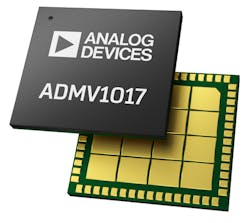In a recent announcement, Analog Devices (ADI) unveiled a highly integrated solution that’s intended to accelerate millimeter-wave (mmWave) 5G wireless network infrastructure. According to ADI, this solution “offers the highest available level of integration to reduce design requirements and complexity in the next generation of cellular network infrastructure.”
Before discussing the new solution, it’s worthwhile to get some insight from Kerem Ok, product line director at ADI. Ok recently weighed in on the mmWave 5G landscape and explained how that’s affecting ADI. “We’re seeing that there’s a concrete push to roll out mmWave 5G, primarily in the U.S. and southeast Asia with the expectation that Europe is going to catch up in the next several years. Our customers are asking us for specific power-efficient, low-cost, high-density offerings that allow them to address this 5G market in which the focus is enabling multi-Gb/s wireless communications for access, backhaul, and fronthaul.”
Ok continued, “Traditionally, wireless access has mostly been associated with sub-6-GHz frequencies. It’s been believed that it’s not possible to deliver information to the consumer at 28 and 39 GHz because of various propagation challenges, atmospheric absorption, requirements for line of sight, etc. However, some of these issues are increasingly being resolved by beamforming. Several different techniques that are part of 5G allow end customers to deliver high-quality data at these bands that were once considered niche.”
ADI’s New mmWave 5G Solution
Everything that Ok mentioned sets the stage for ADI’s new mmWave 5G solution, which includes the 16-channel ADMV4821 dual-polarization beamformer, the 16-channel ADMV4801 single-polarization beamformer, and the ADMV1017 mmWave up/downconverter (see figure). All products cover a frequency range of 24 to 29.5 GHz. Combining the ADMV4821/ADMV4801 beamformer with the ADMV1017 up/downconverter results in a 3GPP-compliant 5G New Radio (NR) mmWave front-end solution that addresses the n257, n258, and n261 bands.
The ADMV1017 mmWave up/downconverter covers a frequency range of 24 to 29.5 GHz.
According to Ok, “the solution is unique because it’s the first wideband 16-channel commercially available dual-/single-polarization beamformer that’s 3GPP compliant across the n257, n258, and n261 bands.” Ok also noted that the solution offers “industry-leading output power, industry-leading noise figure, and several different flexible IP cores that allow ADI to customize the solutions with different integration levels at both the 24- to 28-GHz and 39-GHz bands.”
Ok continued, “One added layer is that our mmWave beams-to-bits capability with enabling algorithms really sets us apart. We are able to add algorithms, addressing array calibration and digital predistortion (DPD), around some of the hardware that we’re offering to really push the envelope in terms of performance levels.”
The 16-channel ADMV4801 single-polarization beamformer and 16-channel ADMV4821 dual-polarization beamformer feature high-resolution vector modulators for phase control. They both also incorporate high-resolution digital-gain amplifiers (DGAs) for amplitude control.
The ADMV1017 mmWave up/down converter offers 1.5 GHz of bandwidth. It has two upconversion modes along with two downconversion modes.


